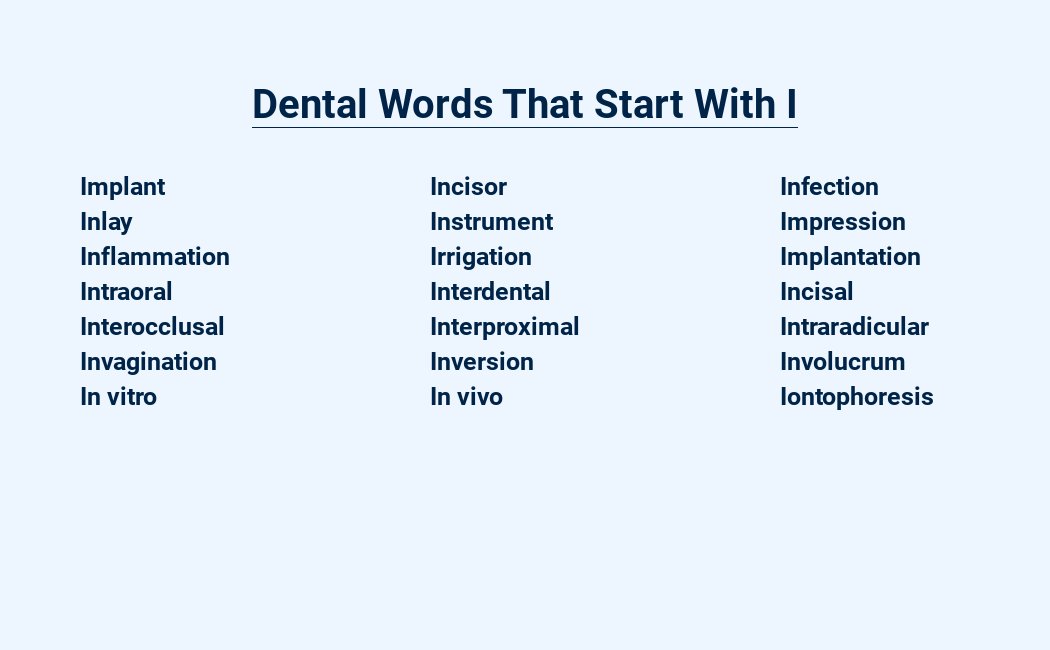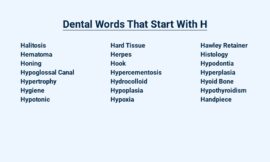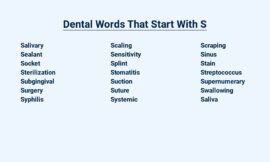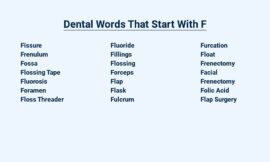Are you seeking a comprehensive guide to dental terms beginning with the letter “I”?
Look no further! This detailed exploration covers essential vocabulary, ranging from incisors, the front teeth responsible for biting, to implants, artificial tooth roots, and more.
Discover the intricacies of dental terminology and enhance your understanding of oral health.
| Word | Definition |
| Incisor | One of the eight front teeth in the upper and lower jaw. |
| Impacted tooth | A tooth that is unable to erupt into the mouth because it is blocked by another tooth, bone, or tissue. |
| Implant | A surgically placed artificial tooth root that is used to support a dental crown or bridge. |
| Impression | A mold of the teeth and gums that is used to create a dental restoration, such as a crown, bridge, or denture. |
| Inlay | A dental restoration that is placed inside a tooth to repair a cavity or other damage. |
| Interdental | Between the teeth. |
| Interproximal | Between the teeth, especially the surfaces of adjacent teeth that touch each other. |
Impacted Tooth: A tooth that is blocked from emerging from the gums, usually due to lack of space.
Impacted Wisdom Tooth: A wisdom tooth that is blocked from emerging from the gums.
Indirect Pulp Capping: A procedure in which a material is placed over exposed pulp to protect it.
Indirect Restoration: A restoration that is fabricated outside the mouth and then cemented into place.
Infective Endocarditis: A serious infection of the inner lining of the heart.
Inferior Alveolar Nerve Block: A local anesthetic injection that blocks the inferior alveolar nerve, which supplies sensation to the lower teeth and gums.
Inflammation: A natural response of the body to injury or infection, characterized by redness, swelling, pain, and heat.
Initial Treatment Plan: The first phase of treatment for a dental patient, which may include diagnostic tests, radiographs, and a cleaning.
Interceptive Orthodontics: Treatment that is used to prevent or correct dental problems in children and adolescents.
Intercuspal Occlusion: The contact between the upper and lower teeth when the jaws are closed.
Interdental Brush: A small, bristled brush used to clean between the teeth.
Interdisciplinary Dentistry: A collaborative approach to dental care that involves multiple specialists working together to provide the best possible care for the patient.
Internal Bleaching: A procedure used to whiten a tooth that has been discolored from the inside.
Internal Fixation: A procedure in which metal plates, screws, or wires are used to stabilize a fractured bone.
Intracanal Medication: A medication that is placed in the root canal of a tooth to disinfect it and promote healing.
Intracoronal Restoration: A restoration that is placed within the crown of a tooth, such as a filling or inlay.
Intraoral Camera: A small camera that is used to take pictures of the inside of the mouth.
Intraligamentary Anesthesia: A local anesthetic injection that is given into the periodontal ligament, which surrounds the root of the tooth.
Intrusion: The movement of a tooth in the direction of the occlusal plane.
Iodine: A chemical element that is used as an antiseptic in dentistry.
Dental Words That Start With I
Incisor
Incisors, the front teeth, are sharp and chisel-shaped, designed for biting and cutting food.
They are the most visible teeth and play a crucial role in speech and aesthetics.
Maintaining good oral hygiene is essential for keeping incisors healthy and strong.
Inlay
Inlay: A custom-made filling that fits precisely within the cavity of a tooth. Inlays are typically made of porcelain or composite resin and are bonded to the tooth to restore its strength and function.
Interdental
Interdental refers to the spaces between teeth.
It is important to keep these areas clean to prevent gum disease and tooth decay.
Flossing is the best way to clean interdental spaces, but interdental brushes and water flossers can also be effective.
Interproximal
Interproximal refers to the area between adjacent teeth, including the contact point, embrasure, and the gingival papilla. It is significant in maintaining periodontal health as food particles and plaque can accumulate in these areas, leading to dental caries and gum disease.
Regular flossing and proper brushing techniques are essential for optimal interproximal hygiene.
Intraoral
Intraoral refers to structures or procedures occurring within the mouth. It encompasses the examination, diagnosis, and treatment of conditions affecting the teeth, gums, and other oral tissues.
Intraoral techniques include visual examination, radiography, and various dental procedures performed within the confines of the oral cavity.
Implant
Implant: A dental implant is a surgical component that interfaces with the bone of the jaw or skull to support a dental prosthesis such as a crown, bridge, denture, or facial prosthesis.
Impression
An impression in dentistry refers to a negative mold of the teeth and surrounding tissues, usually made from a soft material like alginate or silicone. This mold is used to create dental restorations, such as crowns, bridges, and dentures, that fit precisely and comfortably.
Infection
Infection refers to the invasion and multiplication of pathogenic microorganisms, such as bacteria, viruses, or fungi, in the body.
The presence of these microorganisms can cause disease and disrupt normal bodily functions.
Infections can be localized, affecting a specific body part, or systemic, involving the entire body.
Inflammation
Inflammation is a natural response to injury or infection, characterized by redness, swelling, heat, and pain. In dentistry, inflammation is often associated with gum disease, tooth decay, and other oral health conditions.
Understanding inflammation and its causes is crucial for effective dental care and treatment planning.
Final Verdict
Delving into the dental lexicon, we’ve explored a myriad of terms commencing with the letter “I.” From incisors, the sharp-edged front teeth, to inlays, the fillings that restore tooth structure, we’ve delved into the intricacies of dental terminology.
Understanding these terms empowers individuals to engage effectively with dental professionals, enabling informed decision-making regarding their oral health.
By comprehending the nuances of dental vocabulary, we pave the way for improved communication and proactive dental care.




